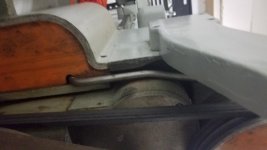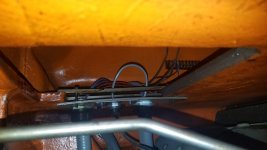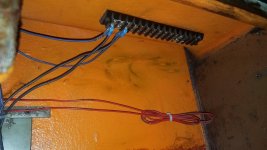Hi,
I bought a 10ee a few years back and only just got it wired up. It seemed to power up, but I couldn't figure out how to get power to the spindle. Looked through the manual, and it turns out the spindle control lever isn't there and it's capped off.
The machine was converted to use a Baldor regenerative drive.
http://www.practicalmachinist.com/v...e-regenerative-digital-dc-scr-control-348089/
Not very sure how to approach this as I'm not that familiar with the machine or the modifications.
I'll add some pics later
My lever and knob "motor switch" is long-gone as well. I didn't want to reach that close to a spinning chuck or faceplate.
Mark (everettengr) placed his DC drive controls at the TS end. 10EE are short of bed, so that would be a good enough location to be reached safely for anyone with average size and arm span.
I want my FWD-OFF/BRAKE-REV controls right on the carriage apron, just right and below of the half-nut lever;. I'll need a flex cable where Mark did not, but the carriage only moves 20 inches or +/- ten inches, so it isn't a great deal of flex.
Per its manual, your 3-Phase-in Baldor 4Q drive is controlled off a low-wattage potentiometer, and/or low power switches, just as our 1-P only Parker-SSD DC Drives are.
It is easy to wire such goods to just about any place you deem convenient.
IF.. the previous owner took advantage of that, the controls could be anywhere on the lathe.
Mine were actually on a test bench fifteen or so feet away from the lathe for much of the experimentation phase! OTOH, the moter was usually out of it and sitting on a platform as well.
That means that "anywhere" from the PO might also include "nowhere". EG: You may not have any controls actually attached at all.
Eureotherm/Parker-SSD 4Q drives are inherently "single knob" capable. If your Baldor was wired the same way, the SPEED control might also be the FWD--OFF/BRAKE--REV control.
One knob.
OFF/BRAKE at center of rotation.
FWD, in one direction, how fast by how far rotated.
REV in the other direction, how fast by how far rotated.
Rotate back to center to brake and stop.
Start with the manual.
ID their control terminals.
Trace existing wires, ELSE attach wires of your own to rcommended switches and potentiometers.
It will all be there in the manual if not also already present "somewhere" on the lathe.











